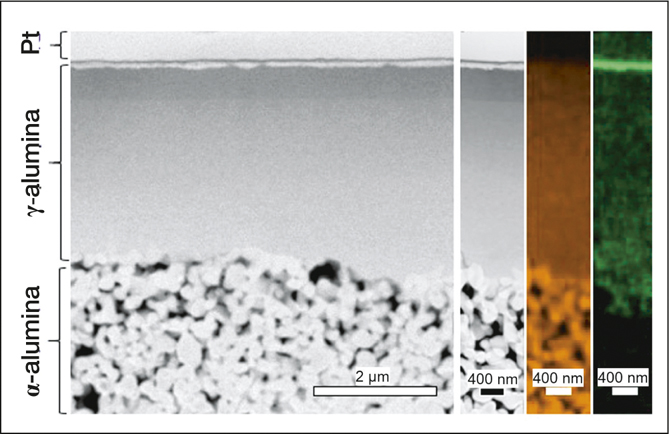Filtration technology is essential for many industrial processes. In particular, oil refinery systems must effectively separate paraffins (such as propane) from olefins (such as propylene) in order to conserve and recover the latter, more precious commodity. To date, most large-scale endeavors have relied on distillation to split these organic molecules. These approaches are expensive and energy-intensive. Membrane-based separations, when combined with distillation, can more effectively separate hydrocarbons than conventional distillation-only industrial systems. A metal–organic framework (MOF) called ZIF-8 (zeolitic imidazolate framework-8), when made into a thin membrane film on a support structure, has been found to effectively separate propylene. The biggest hurdle to implementing this hybrid membrane-distillation process is cost: solution-based solvothermal methods used to form these membranes are difficult and expensive to scale up. An all-vapor membrane synthesis method can eliminate the complexities of a liquid- or gel-based processing approach and is much more attractive. However, existing vapor-based atomic layer deposition (ALD) methods have yet to demonstrate converting precursor components into comprehensive, fully functional membranes.
Now researchers from the University of Minnesota (UMN) have adjusted the synthesis method of the zeolitic imidazolate framework to comprehensively reconstruct the selectively permeable membrane and yield a more industrially scalable method that can be used to separate paraffins from olefins. Xiaoli Ma, Michael Tsapatsis, and their colleagues from UMN’s Department of Chemical Engineering and Materials Science deposited the sieving materials within a porous substrate. Key to their efforts was a two-step vapor-based process that first used ALD with diethyl zinc water vapor to deposit ZnO into a layer of mesoporous γ-alumina on a macroporous α-alumina support. They then transformed the ZnO into a MOF by exposing it to 2-methylimidazole (a volatile organic molecule) in a ligand-induced permselectivation (LIPS) process.

Microstructure of the manufactured membrane is revealed through (left to right) cross-sectional analysis, annular dark-field scanning transmission electron microscopy, and spatial distribution of aluminum (orange) and zinc (green) for the ZIF-8 nanocomposite membrane. Credit: Xiaoli Ma.
The resulting selectivity of propylene over propane was larger than 50, and the propylene flux was high enough to be commercially attractive. The researchers published their approach to capture the propylene olefin in a recent issue of Science (doi:10.1126/science.aat4123).
“By looking at the cross section of the membrane at different stages of fabrication using focused ion beam milling and scanning transmission electron microscopy, we were able to study the penetration of zinc oxide into the porous alumina support at the nanoscale,” says Prashant Kumar, a member of the research team. “This allowed us to tune our ALD method for optimal membrane performance,” he added.
The resulting membranes yielded significantly higher propane/propylene selectivity than comparable zinc-based MOFs that were reported in the past. In addition to being more industrially scalable than conventional solvothermal methods, the combination of an ALD step followed by a LIPS eliminates nonselective gaps, such as pinholes and grain boundaries, in the resulting membranes. The approach by Ma, Tsapatsis, and their UMN colleagues stands to aptly compete with conventional molecular sieving methods in a broad range of industrial and laboratory applications.


